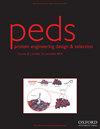Toward the design of efficient transglycosidases: the case of the GH1 of Thermus thermophilus.
IF 2.6
4区 生物学
Q3 BIOCHEMISTRY & MOLECULAR BIOLOGY
引用次数: 7
Abstract
Using the information available in the sequences of well-characterized transglycosidases found in plants, mutations were introduced in the glycoside hydrolase of the bacterium Thermus thermophilus, with the aim of turning it into an efficient transglycosidase. All mutants happen to have fair catalytic efficiencies, being at worst 25 times less efficient than the wild type. Noteworthy, W120F, one of our high transglycosylation yield (≈ 50%) mutants, is only two times less efficient than the wild type. Interestingly, while in the wild type the sidechain of the acid-base is only found able to sample a pair of equivalent conformations during 0.5-μs-long molecular dynamics simulations, its flexibility is much higher in the case of the high transglycosylation yield mutants. Our results thus suggest that engineering the flexibility of the acid-base of a retaining glycoside hydrolase could be a general way to turn it into an efficient transglycosidase.高效转糖苷酶的设计:以嗜热热菌GH1为例。
利用在植物中发现的具有良好特征的转糖苷酶序列的信息,在嗜热热菌的糖苷水解酶中引入突变,目的是将其转化为高效的转糖苷酶。所有的突变体碰巧都有相当的催化效率,最坏的情况是比野生型的效率低25倍。值得注意的是,我们的一个高转糖基化产量(≈50%)突变体W120F的效率仅比野生型低两倍。有趣的是,在野生型中,酸碱侧链只能在0.5 μs长的分子动力学模拟中采样一对等效构象,而在高转糖基化产量突变体的情况下,其灵活性要高得多。因此,我们的研究结果表明,设计保留糖苷水解酶的酸碱灵活性可能是将其转化为高效转糖苷酶的一般方法。
本文章由计算机程序翻译,如有差异,请以英文原文为准。
求助全文
约1分钟内获得全文
求助全文
来源期刊

Protein Engineering Design & Selection
生物-生化与分子生物学
CiteScore
3.30
自引率
4.20%
发文量
14
审稿时长
6-12 weeks
期刊介绍:
Protein Engineering, Design and Selection (PEDS) publishes high-quality research papers and review articles relevant to the engineering, design and selection of proteins for use in biotechnology and therapy, and for understanding the fundamental link between protein sequence, structure, dynamics, function, and evolution.
 求助内容:
求助内容: 应助结果提醒方式:
应助结果提醒方式:


